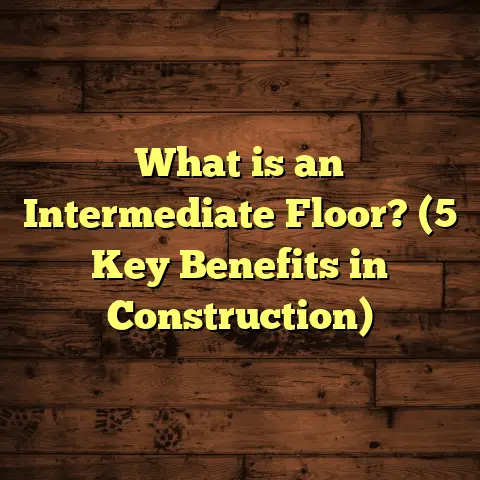What is Floor Elevation? (5 Crucial Facts About Design & Safety)
Have you ever walked into a house and felt a weird sense of imbalance—like your body’s telling you something isn’t quite right even when everything looks perfect at first glance? I can’t count how many times I’ve stepped into a space and instantly known, deep down, that the floor elevation was off. It might sound trivial until you realize how much this hidden detail impacts your home’s look, feel, and—most importantly—safety.
I want to share everything I’ve learned about floor elevation over decades of flooring work, from construction sites to cozy living rooms. Whether you’re a homeowner planning a remodel, a DIY enthusiast, or just someone who loves learning how homes work, understanding floor elevation is a total game-changer. So let’s get into it together!
What is Floor Elevation?
Let’s break it down: Floor elevation is simply the height of a finished floor surface compared to a fixed reference point. That point could be sea level (in big construction projects), the main entry of your home, or the ground outside. Sometimes we use architectural drawings with benchmark markers like “FFL” (finished floor level) or “SSL” (structural slab level).
But what does that mean in real life? Think of it as “where your feet land relative to everything else.” Are your kitchen and living room on exactly the same plane? Does your bathroom step down a little from the hallway? Is the garage floor lower than the house so rainwater doesn’t pour in? These are all questions of floor elevation.
Back in my early days as a contractor, I worked on an old farmhouse with three different floor elevations—one for the original structure, one for the kitchen addition, and one for the back sunroom. Each transition had a weird bump or slope. The owners joked about needing hiking boots just to get from breakfast to their backyard. It was funny—until their granddaughter tripped over a raised threshold and fractured her wrist. That moment really drove home how critical floor elevation is for everyday living.
Floor elevation affects more than just comfort—it shapes safety, accessibility, water management, visual flow, and even your home’s value. And it’s not just for new builds! Retrofits and renovations need careful attention to elevation too.
Why Does Floor Elevation Matter So Much?
You might be thinking: “Isn’t this just splitting hairs?” But let me ask: Have you ever stubbed your toe on an unexpected step? Or fought to get a heavy appliance over a small bump between rooms? Or maybe dealt with mysterious water creeping into the basement after a storm? All these headaches point back to floor elevation.
A slight miscalculation can throw off your entire house’s vibe and functionality. I’ve seen beautifully designed homes lose their wow factor because of a single misaligned step. On the flip side, I’ve helped families transform awkward split-level homes into seamless, open spaces just by adjusting floor heights and transitions.
Let’s explore five of the most impactful facts about floor elevation—how it shapes design and why it’s a big deal for safety.
1. Floor Elevation Directly Impacts Safety
Here’s a stat that’ll stick with you: According to the CDC, falls are the leading cause of injury-related emergency room visits in the United States. Every year, over 3 million older adults are treated for fall injuries—and uneven floors are one of the top culprits! Even healthy adults have been tripped up by unexpected changes in floor height.
I’ll never forget one client—a retired couple who’d lived in their split-level ranch for 40 years without issue. But when their grandkids started visiting more often, they realized those two steps down into the den were an accident waiting to happen. One wrong leap during a game of tag nearly led to disaster.
So why do these little bumps cause so much trouble?
Our brains are wired to expect continuity underfoot. When there’s even a small change (as little as half an inch), it throws off our stride. We lift our feet too high or not enough. The risk doubles for older folks or anyone with limited mobility.
Safety Statistics That Might Surprise You
- The National Safety Council reports that falls account for over 8 million hospital emergency room visits annually—about 21% of all ER visits.
- The CDC estimates that 20–30% of people who fall suffer moderate to severe injuries such as bruises, hip fractures, or head trauma.
- According to a study published in “Accident Analysis & Prevention,” homes with uneven floor levels or unexpected steps had 67% more fall incidents than those with flush transitions.
Real-World Example
At one apartment complex I worked on in Chicago, residents complained about a ¾-inch lip where new tile met old hardwood in the hallway. Over six months, three people tripped badly enough to file injury reports. We fixed it with a simple tapered transition strip—problem solved.
Key Lesson: Even tiny changes in elevation matter—a lot! If you’re renovating or building from scratch, aim for flush transitions wherever possible. If you absolutely have to change heights, use gentle slopes or conspicuous markings.
Codes and Best Practices
Building codes aren’t just bureaucratic red tape—they’re lessons learned from years of real-world injuries.
- Most U.S. codes specify that any change in floor elevation greater than ½ inch requires either a ramp or transition.
- The Americans with Disabilities Act (ADA) says that vertical changes up to ¼ inch don’t need anything special; between ¼ inch and ½ inch must be beveled (sloped); anything higher needs a ramp with no more than a 1:12 slope.
- International Residential Code (IRC) recommends no more than ½-inch difference between adjacent floors unless there’s a threshold ramp.
After years of seeing preventable injuries firsthand, I follow these rules religiously—even if local inspectors are lax!
2. Drainage and Moisture Management Depend on Proper Elevation
Want to know what keeps me up at night as a contractor? Water damage! It’s sneaky, expensive, and absolutely unforgiving when you get floor elevation wrong.
Water follows gravity—it always finds the lowest spot. If your finished floors are too low compared to outside grade or nearby rooms, you’re basically inviting moisture in. That means warped wood, mold growth, ruined carpets, and sometimes full-on flooding.
Data That Drives My Work
- Water damage affects about 14,000 U.S. homeowners daily according to Insurance Information Institute data from 2021.
- The average cost of water damage restoration ranges from $3,000–$7,500—but can balloon much higher for basements or lower levels.
- FEMA recommends a minimum difference of 6 inches between exterior ground level and finished floor level for homes in flood-prone areas.
Case Study: When Elevation Saved Thousands
I once helped a family in suburban Houston who’d had three “100-year” floods in five years (thanks climate change). Their builder had set their finished floor just two inches above grade—big mistake! Rainwater pooled against the foundation and seeped into their beautiful new hardwood every spring.
During renovation, we raised the entire slab by four inches using lightweight concrete fill. It was expensive upfront—about $15K for their 2,000-square-foot footprint—but after Hurricane Harvey hit later that year, they were bone dry while neighbors dealt with muddy carpets and ruined drywall.
What Can Go Wrong?
- Basements: If your basement slab isn’t elevated above the water table or exterior soil line, hydrostatic pressure can push water up through cracks.
- Bathrooms & Laundry Rooms: These should always slope gently toward drains (⅛ inch per foot minimum). Even small dips can pool water under tile or vinyl.
- Entryways & Garages: Garages are usually set 4–6 inches lower than interior floors to prevent carbon monoxide from seeping inside—and to keep rain out!
How I Help Clients Avoid Nightmares
I always recommend:
- Checking local flood maps before setting final elevations.
- Using laser levels to confirm slopes away from doors and foundations.
- Adding foundation drains or sump pumps if you’re at risk for groundwater intrusion.
- Never skimping on exterior grading—your landscaping should always drain away from your house!
3. Accessibility Starts With Floor Height
If you’ve ever tried to help someone in a wheelchair—or even pushed a stroller or rolling suitcase across an entryway—you know that even tiny bumps feel like mountains.
Accessibility isn’t just about ramps and wide doorways; it starts with consistent floor heights across living spaces.
Personal Story
My own grandmother lived independently into her late eighties. She was fiercely proud but struggled with arthritis and used a walker. Every visit ended with her gingerly stepping up onto her porch—just two inches higher than her walkway. One winter she slipped on ice at that very spot and broke her ankle.
After her fall, I ripped out her porch threshold and rebuilt it flush with the entryway using weatherproof materials. It made all the difference—not just for her safety but for her dignity.
ADA Requirements (And Why They Matter)
The Americans with Disabilities Act sets clear standards:
- Changes in level up to ¼ inch: No treatment needed.
- Between ¼ inch and ½ inch: Must be beveled with a max slope of 1:2.
- Higher than ½ inch: Requires a ramp with max slope of 1:12 (one inch rise per twelve inches run).
But accessibility isn’t just about legal compliance—it’s about making homes welcoming for everyone. I’ve seen parents struggle with strollers at an unexpected step; houseguests hesitate at tricky thresholds; delivery workers curse at steep garage entries.
Statistics That Prove The Point
- The National Association of Home Builders found that “universal design” features (including flush floor transitions) increase resale value by up to 10%.
- AARP reports that nearly 90% of seniors want to age in place—which means fewer steps and level transitions make homes more marketable as we all get older.
- Zillow’s research in 2022 showed listings mentioning “accessible entry” or “no-step” entries sold six days faster than average in competitive markets.
Common Accessibility Pitfalls
- Sunken Living Rooms: They look cool but are tough for anyone with mobility issues.
- Step-Up Showers: Curb-less showers are much easier for aging in place.
- Garage-to-House Entries: These should have flush thresholds whenever possible—or wide ramps if needed.
When I design or remodel spaces now, I literally walk through them as if pushing a wheelchair or walker—even if nobody in the home has mobility needs today. Because you never know what tomorrow brings!
4. Design Aesthetics Are Shaped by Floor Elevation
Let’s talk style for a second because floor elevation isn’t just about practicality—it can totally change how open or cozy your home feels.
Think about those gorgeous open-concept kitchens you see on Instagram. What makes them feel so seamless? Nine times out of ten, it’s perfectly matched floor heights from one space to another.
But sometimes designers use changes in elevation intentionally—to define zones or add drama.
Current Trends: Flush is In
The National Kitchen & Bath Association surveyed 500 designers in 2023:
- 82% said their clients preferred flush transitions between kitchens and living rooms.
- Only 6% wanted sunken living rooms—a huge drop from the mid-century era!
- Wide plank floors laid continuously across rooms (with matching heights) were rated as #1 for creating an expansive look.
When I remodeled my own house last year, my wife insisted we get rid of the step down into our family room. Once we raised the subfloor by two inches and installed continuous white oak planks throughout, it felt like we’d added several hundred square feet—just by removing that psychological barrier.
When Different Heights Work
That said, there are times when intentional elevation changes create stunning spaces:
- Split-Level Homes: A few steps up or down can help separate public vs private zones.
- Sunken Conversation Pits: Retro but still fun if well-executed!
- Loft Areas: Raised platforms for sleeping nooks or offices can add interest without sacrificing function.
But remember: every step or slope should be clearly marked—especially if lighting is low.
Tips From Experience
If you want visual separation without changing heights:
- Use different flooring materials (tile vs wood).
- Add area rugs to “zone” spaces.
- Play with ceiling heights or pendant lighting instead of steps.
My rule of thumb: Design for life’s realities first (kids running around, aging parents), then add style flourishes that don’t compromise function.
5. Construction Costs and Timeline Are Affected by Floor Elevation Choices
Here’s where things get real: Changing floor elevation—even by an inch—can seriously impact both your budget and your schedule.
Most people assume flooring is simple: just lay it down! But matching heights between rooms can require major prep work underneath that beautiful hardwood or tile.
Where Does The Money Go?
According to HomeAdvisor data from 2023:
- Adjusting subfloors for elevation differences adds $3–$8 per square foot.
- Raising an entire sunken room (framing + new subfloor) can cost anywhere from $8K–$15K depending on size and finishes.
- Don’t forget about labor—complex transitions mean more time on site!
I once quoted a job where the homeowner wanted every room in their mid-century split-level leveled out. In some spots we had to add new joists; elsewhere we floated new subfloors above existing ones; all door frames needed modification too. The total added cost? Over $18K—about what they’d budgeted for all new appliances!
Timelines Matter Too
Floor elevation changes almost always extend project timelines:
- Subfloor leveling compounds need time to cure (24–72 hours).
- Structural work means inspections—and sometimes permit delays.
- Flooring installers may need extra days for custom trim work at thresholds.
One bathroom remodel I managed ran four weeks late because we discovered an unexpected drop in the joists under old linoleum. We had to reframe half the room before laying tile!
How To Plan Smart
Use digital tools like FloorTally before starting demo day:
- Model different height scenarios.
- See how added subfloors affect door swings and cabinet heights.
- Get detailed cost breakdowns so there are no surprises later.
I always say: spend an extra hour planning elevations upfront and you’ll save days (and dollars) later!
Common Floor Elevation Mistakes (And How To Fix Them)
Let me pull back the curtain on some classic mistakes I see—and how you can avoid them:
Mismatched Flooring Thickness
Switching from thick tile (say ¾ inch) to thin laminate (¼ inch)? Don’t just lay it down without adjusting underlayment thicknesses—you’ll end up with an ugly bump at the transition!
Fix: Order custom underlayment sheets or self-leveling compound to bring thinner floors up to match adjacent thicker ones before installing finish material.
Forgetting Finished Floor Height
It’s easy to plan everything around subfloors but forget that hardwood planks or plush carpet will add height after installation—and affect door clearance or cabinet toe kicks.
Fix: Always factor in the full thickness of ALL flooring layers—including underlayment—when measuring door jambs and cabinetry!
Ignoring Expansion Gaps
Floating floors like laminate need expansion gaps around all edges so they don’t buckle as humidity changes—but those gaps also affect transition heights at doorways.
Fix: Use T-moldings or reducer strips designed for your exact plank thicknesses so transitions stay safe AND beautiful!
Assuming Old Homes Are Level
Newsflash: They never are! Sagging joists and old settling mean floors often dip or rise unpredictably across rooms.
Fix: Invest in laser levels—and never trust your eyes alone! Map out high/low spots before finalizing any plans.
Data-Backed Design: Floor Elevation Adds Value
If you’re thinking long-term investment as well as comfort, here’s some data you’ll love:
Zillow’s research shows homes advertising “accessible features” sell six days faster than their competitors—and often fetch higher prices per square foot. Buyers want peace of mind knowing they won’t have trip hazards if kids come along…or if grandma moves in someday.
Remodeling Magazine’s Cost vs Value report found projects improving accessibility—including adjusted elevations—recouped around 68% of costs on resale nationally in 2023.
The National Association of Realtors polled recent buyers:
- 57% called accessible entries “very important.”
- 44% said they’d pay extra for smooth transitions between garage/house/kitchen spaces.
So whether you’re aging in place or planning for resale down the road, smooth elevations are money well spent!
Case Study: Modernizing A Split-Level Home For Family Life
Let me tell you about one job I’ll never forget—a classic split-level ranch built in the late ’60s on Chicago’s north side.
The homeowners loved their big open living/dining space but hated how every bedroom sat half a flight above or below the main level. With two young kids and hopes of hosting their elderly parents overnight someday, those steps were getting old fast.
We spent weeks modeling new elevations using FloorTally:
- Option A: Level all floors by raising lower rooms AND lowering some ceilings (costly!).
- Option B: Keep steps but widen them into shallow ramps that met ADA guidelines.
- Option C: Only level key areas—the kitchen/family room zone where everyone gathered most often.
They chose Option C since it balanced budget ($14K extra) with daily function improvements:
- We raised their sunken family room by six inches using lightweight steel joists topped with plywood subfloor.
- Added reducer strips at doorways where full leveling wasn’t possible.
- Installed continuous LVP planks across kitchen/family zones for seamless flow—a big hit at parties!
End result? Their parents could visit safely; kids raced around without fear; future buyers saw “universal design” value baked right in.
Quick Tips For Getting Floor Elevation Right
Here’s my personal cheat sheet after decades on job sites:
- Measure Everything Twice: Use laser levels—not just tape measures—to check every corner before ordering materials.
- Plan Transitions Early: Don’t wait until installation day! Know where every bump will be (or won’t).
- Think About Furniture: Heavy pieces can wobble if floors aren’t even; appliances may not fit right under countertops if heights vary!
- Account For Future Needs: Will aging parents visit? Could someone need mobility aids someday?
- Use Professional Estimators: Tools like FloorTally help visualize costs/risks before work starts so there are no budget-busting surprises later!
- Document Everything: Take photos and notes during demo so you know where problems are hiding under old floors!
- Consult Local Codes: Always double check requirements before finalizing plans—they exist because someone else already learned the hard way!
Frequently Asked Questions (From Real Clients)
Q: Can I raise my sunken living room without tearing out all my floors?
A: Sometimes! It depends on ceiling height (so you don’t lose too much headroom) AND whether existing structure can support added weight safely. Lightweight steel framing helps—but always consult an engineer first!
Q: Are small steps between rooms really that dangerous?
A: Yes—especially for older adults or kids who move fast! Even one-inch bumps can cause trips if they’re not clearly marked or sloped gently enough.
Q: My new hardwood doesn’t match my old tile—what should I do?
A: Use transition strips designed for your specific thicknesses OR build up thinner areas with underlayment so everything meets flush before laying final finish!
Q: How do I know what my local code says about floor elevations?
A: Your building inspector is your friend! Most city/county websites post residential code summaries online—or ask your contractor (if they don’t know offhand…find someone else!).
My Own Advice After Years In Flooring
If there’s one takeaway here, it’s this: Don’t let floor elevation become an afterthought! It shapes every aspect of daily life—from safety when carrying groceries through the garage…to comfort when kids run across open concept spaces…to peace of mind knowing aging relatives can visit without risk of falls.
Every time I walk onto a new jobsite now, I start by asking:
- Who lives here now?
- Who might live here someday?
- What worries keep them up at night? Your answers shape every decision about how high—or low—I set those floors.
And trust me—get this right early on and everything else falls into place seamlessly (pun intended!). Get it wrong…and no amount of beautiful finishes will fix bad bones underneath.
So next time you’re planning new flooring—or tackling a full remodel—take time up front to walk through your space barefoot…think through every transition…and ask plenty of questions about what lies beneath!
If you’re not sure how your project stacks up? Use tools like FloorTally to run numbers before demo day; call experienced pros; poke around local code books online; talk to neighbors who’ve been through renovations recently! A few hours spent researching now will save thousands—and countless headaches—down the road.
Final Thoughts: Why Floor Elevation Is The Quiet Hero Of Great Homes
Here’s something most glossy magazines won’t tell you: The best flooring jobs aren’t always noticed—they feel right before they ever look right. People may not notice why they love walking barefoot across your kitchen…or why grandparents move confidently from porch to hallway…but that quiet sense of ease starts with perfect planning underneath their feet.
I’ve seen stunning homes undone by clumsy steps; average spaces elevated by smart transitions; families breathe easier when every threshold feels safe and seamless—not just stylish on day one but livable for years ahead.
So if you remember nothing else from this deep-dive into floor elevation—just remember this question:
“Will everyone who lives here today…and everyone who visits tomorrow…move easily from room to room?”
If so? You’ve nailed it—even if nobody ever notices all the hard work beneath their feet. And honestly? That’s the highest compliment any flooring pro could hope for!
If you want more insider tips or need help planning your next project—reach out anytime! I’m always happy to walk through ideas (and share more stories) because every great home starts—with its floors firmly grounded—on solid ground.





